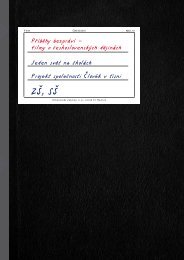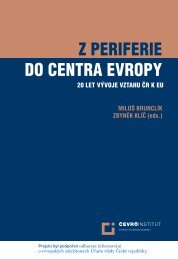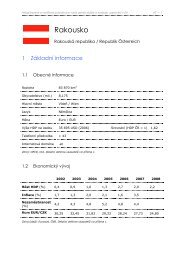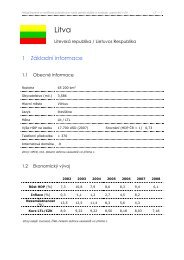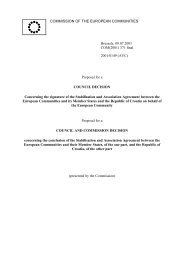CESTA KE SVOBODÄ PÅÃBÄHY BEZPRÃVÃ - Euroskop.cz
CESTA KE SVOBODÄ PÅÃBÄHY BEZPRÃVÃ - Euroskop.cz
CESTA KE SVOBODÄ PÅÃBÄHY BEZPRÃVÃ - Euroskop.cz
- No tags were found...
You also want an ePaper? Increase the reach of your titles
YUMPU automatically turns print PDFs into web optimized ePapers that Google loves.
In October 1948, Act No. 231/1948 of the Collection of Laws, on the protection of thepeople’s democratic republic, was approved, and this became one of the main instrumentsof judicial persecution. Forced labour camps began to be established and – as the historianTomáš Bursík puts it: “with a whole range of other measures [the KSČ] made it very obvious how itwas going to deal with all its opponents”.A lonely struggle – Prokeš and Borkovec’s attempted coup,the Žatec affairConsequently, the end of 1948 marked a watershed for active resistance to the regime.Only the bravest people (or possibly those with the biggest sense of adventure) persistedin pursuing this course or decided that it was the path they were going to follow. A typicalresistance movement did not exist in the country (if we understand this to meancoordinated action against an illegitimate regime led by a universally respected centralauthority, which is usually based abroad). Anti-communist groups were isolated and werethus effectively doomed to failure. The members of these groups were no different fromthe majority of society in terms of who they were or what they thought, but they decidedfor themselves to try and take some action against the regime. They were perhaps alsodistinguished by their willingness to wage a lonely struggle. They didn’t want to wait forsomeone else to provide their freedom. Very often they were inspired by the anti-Naziresistance movement or had direct experience of opposing the Nazis. The Prague Uprisingof May 1945 was still fresh in people’s memory and it was hoped that some army leaderswould be instrumental in bringing about a change of regime. There actually were somecoup attempts by soldiers. The most prominent of these efforts was an attempted putsch byKvětoslav Prokeš and Jaroslav Borkovec.When the communists seized power in February 1948, Major Květoslav Prokeš (who hadfought on the Western and Eastern Fronts as well as in the Middle East during WWIIand who was thrown out of the army for political reasons after the War) started to thinkabout overthrowing the KSČ government and restoring democracy in the country. Whenhe became friendly with the Prague lawyer and pre-War politician Dr. Jaroslav Borkovec,the pair of them began preparing a coup together. They wanted to temporarily entrustthe running of the country to special military units, who would be headed by the (thenimprisoned) general and leader of the Prague Uprising Karel Kutlvašr. They recruited ortried to enlist important military squadrons throughout the entire country for their planand they decided that the coup would take place three hours after midnight on 17 May1949. A few days before the planned operation, however, they learned that another groupwas also planning a putsch, but at a later date. They met with this faction’s representativeMiloš Vokurka-Borovička (who was probably a StB collaborator), but they could not findany common ground. They agreed to meet again, but on 16 May Prokeš, Borkovec andother members of their group were arrested. A huge trial began two months later in whichalmost 60 people were indicted. Prokeš and Borkovec were sentenced to death (along withfour other people) and they were executed on 5 November 1949. Their fellow conspiratorRudolf Hrbek was sentenced to life imprisonment. (He was released in 1963.) The chargeswere dropped against Vokurka-Borovička.Other coup attempts included the so-called Žatec Affair (which is also known as the “ŽatecOperation” or “Prague-Žatec”). Major Miroslav Jebavý (who had spent 16 years abroad, 10 ofwhich were with the foreign legion) played a major role in this event. After February 1948,he joined forces with Karel Sabela (who was captain of a tank brigade as well as a veteranof the Western Front) and Bohuslav Hubálek, a merchant and decorative painter fromPrague. They established contact with officers of the general staff and the national defenceministry in Prague as well as with officers of some military units. Altogether there werearound 300 people in the group. The coup was supposed to take place on 8 March 1949, butthe plot was leaked and the conspirators were arrested. Jebavý, Sabela, Hubálek and twoother plotters were sentenced to death and executed in July 1949.The extent to which these coup attempts were controlled by the secret police andmilitary counter-intelligence or the length of time they were being monitored is still notcompletely clear to this day. Of course, this does not detract from the determination andendeavour of a huge number of decent people who simply decided that they were going totake action against the regime. Similarly, it is also debatable as to whether the attemptsto overthrow the communist government in 1949 had any hope of triumphing. In view ofthe Communist Party’s powerful administrative machinery and Czechoslovakia’s absolutesubordination to Moscow, it is likely that not one of the coups would have been successful.And even if they had, the country would still have been unable to remain outside theUSSR’s sphere of influence. “Failure”, however, is a relative term. If the Czechs hadrevolted and made it clear in a wholesale manner that they did not want a communistgovernment, it could have given rise to other forms of resistance and the subsequentdecades might have turned out differently.Armed groups – Černý lev 777, Světlana, Hory HostýnskéBesides groups that tried to seize control of the state, a number of smaller, armed localorganisations also operated in Czechoslovakia. The most famous example is that of thebrothers Ctirad and Josef Mašín and their associates. This group first waited to see whethera revolt would break out before deciding to fight against communism on their own account.In the autumn of 1951, they attacked two police stations in order to acquire weapons.A National Security Corps officer was killed during both operations. A year later, they triedto obtain funds for their resistance activity by attacking a vehicle transporting workers’wages. They killed a cashier in the course of the robbery. In 1953, they decided to flee toWest Berlin and join the American army. After a dramatic escape, the brothers actuallymade it to the West with Milan Paumer. Naturally, the remaining three members of theirgroup were apprehended and sentenced to death.Other anti-communist groups included organisations like Černý lev 777 (”Black Lion 777”),which was active in the Sedlčansko and Milevsko districts. They began by accumulatingweapons and carrying out minor sabotage operations. They then gradually startedtaking tougher action. In the years 1949 and 1950, members of this group attacked twoCommunist Party secretariats with explosives. During one of the attacks, they fatallywounded an officer of the National Security Corps who had been guarding the secretariat.The secret police were quite slow in hunting down the members of Černý lev 777, but34 | 35





